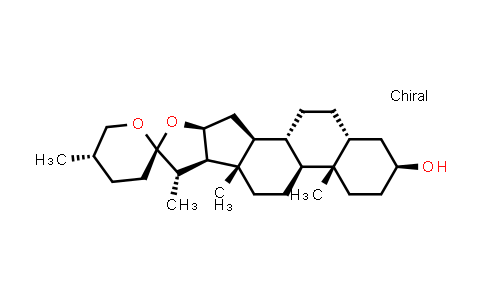| Chemical Name |
Sarsasapogenin |
| CAS Number |
126-19-2 |
| MDL Number |
MFCD00270414 |
| Molecular Formula |
C27H44O3 |
| Molecular Weight |
416.64 |
| Synonyms |
Parigenin;Sarsagenin |
Introduction of 126-19-2 :
Sarsasapogenin is a sapogenin from the Chinese medical herb Anemarrhena asphodeloides Bunge, with antidiabetic, anti-oxidative, anticancer and anti-inflamatory activities. In Vitro: Sarsasapogenin (20-80 μM) induces apoptosis via caspase-dependent mitochondrial pathway in heLa cells. Sarsasapogenin also induces apoptosis via the caspase-dependent mitochondrial apoptotic pathway. Sarsasapogenin (60 μM)-induced ROS generation triggers ER stress and mitochondrial dysfunction[1]. Sarsasapogenin potently inhibits NF-κB and MAPK activation, as well as IRAK1, TAK1, and IκBα phosphorylation in LPS-stimulated macrophages. Moreover, Sarsasapogenin inhibits the binding of LPS to macrophage Toll-like receptor 4, and polarization of M2 to M1 macrophages[3]. In Vivo: Sarsasapogenin (20 and 40 mg/kg) significantly restores the sucrose preference deficit induced by olfactory bulbectomy (OB), and increases locomotor activity. Sarsasapogenin groups (20 and 40 mg/kg) have significantly lower immobility times, higher AChE protein expression levels than the OB group. Furthermore, Sarsasapogenin (20 and 40 mg/kg) groups have significantly higher α7-nAChR protein expression, and increases higher α4-nAChR protein expression levels compared to rats in the OB group[2]. Sarsasapogenin (5 or 10 mg/kg, p.o.) inhibits TNBS-induced colon shortening and myeloperoxidase activity in mice, reducing NF-κB activation and interleukin (IL)-1β, tumor necrosis factor (TNF)-α, and IL-6 levels, while simultaneously increasing IL-10[3].
| Purity |
NLT 98% |
| Storage |
at 20ºC 2 years |
*The above information is for reference only.
